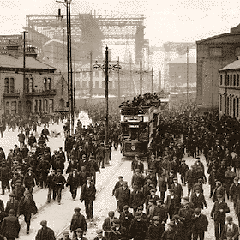 The
enormity of these White Star liners would be like nothing ever seen. Not
only would the leading Cunard ships be a mere two thirds the size of Olympic
and Titanic, but building Olympic and Titanic required Harland
and Wolff to build special gantries and convert the area that ordinarily
accommodated the construction of three ships. These berths would soon be
fully occupied by two ships, both nearly a sixth of a mile in length. The
third sister, Gigantic, subsequently renamed Britannic,
was to be built at a later date.
The
enormity of these White Star liners would be like nothing ever seen. Not
only would the leading Cunard ships be a mere two thirds the size of Olympic
and Titanic, but building Olympic and Titanic required Harland
and Wolff to build special gantries and convert the area that ordinarily
accommodated the construction of three ships. These berths would soon be
fully occupied by two ships, both nearly a sixth of a mile in length. The
third sister, Gigantic, subsequently renamed Britannic,
was to be built at a later date.About five and a half months after final approval of the plans, in December of 1908, construction began on Olympic. While work proceeded swiftly on Olympic, three and a half months in March of 1909, the keel of the second sister was laid. The construction of Titanic was underway.
 For over a year, nearly fifteen thousand workers at Harland Wolff toiled
as the two ships took form side by side in their berths until October 10,
1910. Nearly two years after her construction began, Olympic was
launched. She was the largest moving object ever to be created by human
beings. Likewise, Titanic would be such, as she would be slightly
larger than Olympic. Moreover, Titanic would receive
modifications and advancements based on experience gained by Olympic's
construction.
For over a year, nearly fifteen thousand workers at Harland Wolff toiled
as the two ships took form side by side in their berths until October 10,
1910. Nearly two years after her construction began, Olympic was
launched. She was the largest moving object ever to be created by human
beings. Likewise, Titanic would be such, as she would be slightly
larger than Olympic. Moreover, Titanic would receive
modifications and advancements based on experience gained by Olympic's
construction.On May 31, 1911, Titanic was launched before thousands of spectators, including American financier J.P. Morgan, the owner of the White Star Line's parent companies International Mercantile Marine and the Oceanic Steam Navigational Company. Bruce Ismay was also in attendance, along with Lord Pirrie, his wife, and the mayor of Belfast. At 12:13 p.m., Titanic was released into the River Lagan.
Later that day, Harland and Wolff formally delivered Olympic to the White Star Line. The Olympic set sail for Liverpool that afternoon with Morgan and Ismay as proud passengers. While Titanic was being completed, Olympic would eventually leave on her maiden voyage and quickly capture the attention and applause of travelers.